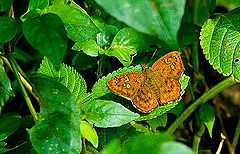- Pseudocoladenia dan
-
Fulvous Pied Flat Scientific classification Kingdom: Animalia Phylum: Arthropoda Class: Insecta Order: Lepidoptera Family: Hesperiidae Genus: Pseudocoladenia Species: P. dan Binomial name Pseudocoladenia dan
(Fabricius, 1787)Synonyms Coladenia dan
Pseudocoladenia dan, commonly known as the Fulvous Pied Flat, is a butterfly belonging to the family Hesperiidae.
Description
For terms used, see glossary of Lepidopteran terms."Wings above rufous-brown; anterior wings with four discal greyish white spots, one largest and sublunate in cell, a small spot above it, and two beneath cell divided by the second median nervule, and three sometimes two small subapical greyish-white spots in suberect series, outer half of wing with obscure dark fasciae; posterior wings with discal and outer marginal dark fasciae. Wings beneath as above, but slightly paler. Body and legs more or less concolorous with wings.
Recorded from Kumaon (Doherty); Sikkim (de Nicéville, Elwes); Cachar (Wood-Mason and de Nicéville); Kangra, N.-W. Himalayas (Moore); Nilgiris (Hampson).
Race andamanica: "Specimens from Port Blair differ from continental ones in having the discal series of spots all run together so as to form an unbroken band, and the three subapical spots conjugated and in the same straight line, with their conjoined inner margin nearly straight and their outer festooned; and two examples exhibit in addition two smaller dots placed nearly parallel to the outer margin just below and external to the three subapical ones." (Wood-Mason and de Niceville in J. A. S. B., vol. I.) Habitat: Andamans, Cachar.[1]
In recording this variety from Cachar, Messrs. Wood-Mason and de Niceville note that specimens from that locality differ from Andaman specimens in the discal golden band of the upperside of the forewing being slightly broader, and the yellow spots on the underside of the hindwing obsolete; and that it agrees with P. dhanada, Moore, in the golden band not nearly reaching the anal angle of the forewing on the upperside (thereby differing from P. aurivittata, Moore), departing from it in having the cilia cinereous throughout (J. A. S. B., vol. lv).
References
- ^ Watson, E. Y. 1891. Hesperiidae Indicae: descriptions of the Hesperiidae of India, Burmah and Ceylon. Madras.

This Pyrginae-related article is a stub. You can help Wikipedia by expanding it.

